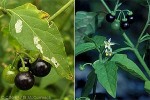Cook Islands Biodiversity Database
Species Page
Solanum americanum
PoroporoSmall-flower Nightshade
Multimedia & Additional Resources
| Type | Description | Download |
| Leaves, flowers and fruit | 43KB | |
| compare Solanum nigrum (NZ) | 85KB | |
| ?Solanum forsteri (Gambier Group) | 51KB |
General Information
Cook Islands Distribution
| Southern Group: Present Makatea: Present | ||||||||
RR |
MG |
AT |
MK |
MT |
AK |
PL |
TK |
MN |
+++ |
++++ |
+++ |
+ |
P |
+++ |
P |
- |
|
| Northern Group: Present | |||||
TN |
MH |
RK |
PK |
NS |
SW |
- |
++? |
- |
- |
- |
|
Scientific Taxonomy
Solanum americanum Mill.
SYNONYMS: Solanum americanum nutans; Solanum nigrum Linnaeus [mistaken, authors incl. GW]; Solanum oleraceum [mistaken TC]; Solanum nodiflorum Jacq.; Solanum nodiflorum nutans R.J.Henderson; Solanum forsteri Seem. [mistaken]
TAXONOMY: PLANTAE; ANTHOPHYTA (=Angiospermae); MAGNOLIOPSIDA (=Dicotyledones); ASTERIDAE; Solanales; SOLANACEAE
More Information
SIGNIFICANCE NOTES -
POSITIVE SIGNIFICANCE: Medicine, vegetable (+1). Comments: Cheeseman (1903) noted that this plant was often planted near dwellings and used as a potherb (=cooked vegetable), and the leaves are still sometimes cooked. Fruits are eaten raw in, at least, Hawaii, Peru and Bolivia.
NEGATIVE SIGNIFICANCE: Weed - minor. Comments: A minor weed in gardens.
GENERAL NOTE: Cheeseman (1903) noted Solanum americanum (as Solanum oleraceum) in waste areas and often planted near dwellings and used as a potherb, it is not clear if he considered it Native or Polynesian Introduced (it is not in his list of such plants, but neither are Solanum repandum or Solanum uporo, which were Polynesian Introduced).
Solanum americanum was first collected in Hawaii in 1835 and claimed by Hillebrand (1888) as indigenous, and Allen (1981) found seeds in an archaeological site adze quarry that was abandoned before Cook's arrival [Wagner et.al]. Whistler (1994, Wayside Plants of the Islands) says "apparently a native species of the Pacific Islands, although it probably originated somewhere in tropical America."
The Forsters on Rapanui with Captain Cook collected Solanum nigrum?, later Solanum forsteri Seem., which recently has considered a synonym of Solanum americanum. However, this plant is now likely to be a valid species as Solanum forsteri, including Solanum insulae-paschalis as a synonym, with a distribution Juan Fernandez, Easter Island, Tahiti and Society Islands [email J.Edmonds, 2006/Jan]. Although thought to be extinct this plant was rediscovered in the wild on Rapanui in 2005 by C.Cristino [email C.Cristino, 2006-03]
Vouchers & References
Vouchers:
None Recorded.
References:
p.1268 Wagner et al.- Flowering Plants of Hawaii
p.744 Neal - In Gardens of Hawaii
p.5/012 A.C.Smith - Flora Vitiensis Nova
p.289 N Cheeseman - Flora of Rarotonga
p.96 Wilder - Flora of Rarotonga
p.393a Whistler - Ethnobotany of the Cook Islands
Data Update History (information):
zTX, zB02, zM02, zupM06a
Web Resources
Citation Information
McCormack, Gerald (2007) Cook Islands Biodiversity Database, Version 2007.2. Cook Islands Natural Heritage Trust, Rarotonga. Online at http://cookislands.bishopmuseum.org. ![]()
Please refer to our use policy.

